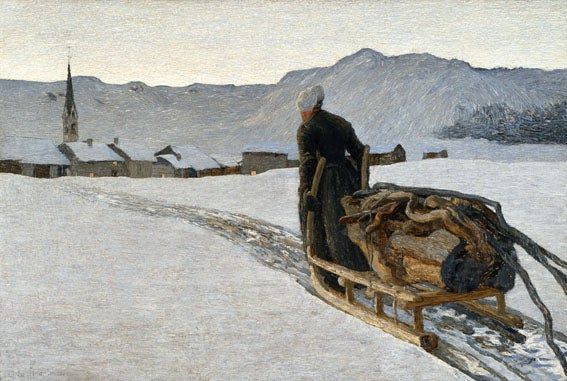Radical Light: Italy's Divisionist Painters 1891-1910, National Gallery, London
An episode that should have stayed buried

The trouble with the National Gallery's exhibition, "Radical Light", is that it is dominated by Gauguin and Signac, Seurat, Millais and Courbet. Not that any of these artists is actually in the show. Instead, we are given approximate work by a group of painters with names like Pellizza, Morbelli and Segantini, of whom, unless late 19th-century Italian painting happens to be your bag, you may never have heard, and who it is unlikely you will want to hear of again.
By the time of Italy's Unification in 1871, local painting was two centuries past its sell-by date. The political Risorgimento had not been matched by a resurgence in art. While the French were inventing Impressionism – Monet painted Impression, Sunrise in 1872 – the country that had given the world Leonardo, Michelangelo and Raphael was sitting on its painterly hands. Added to the embarrassment of past glories, Italian artists had to cope with being Italian artists: that is to say, with finding a national voice for a state which, pre-Garibaldi, had been dozens of fiercely antipathetic mini-states. The Florentine Renaissance or Roman Baroque had belonged to Florence and Rome, not to Italy.
And so was born Divisionism, a name derived from its practitioners' habit of using thin, thread-like brush-strokes of unmixed (or divided) pigment. These derived from the optical theories of Ogden N Rood, an American physicist who held that light was produced by the oscillation of adjoining colours. Apply these colours in the Divisionists' close-knit dabs and your picture would become that magical thing, its own light source.
You can see why this might appeal to a group of painters, themselves pretty disparate, who were trying to conjure up a unified state. As well as being evocative nationally, Divisionism was modern. If Italians had missed the Impressionist boat, they could at least sign up to Neo-Impressionism as practised by Pissarro, Signac and, above all, Seurat. One of the many annoying things about "Radical Light" is that the influence of Seurat's Pointillism on Segantini and the rest is dismissed in one line of catalogue: "they had little or no first-hand experience [of it]". This may be true, but it neglects the huge role played by books, journals and word-of-mouth in shaping trends in art. To suggest that Divisionist painting somehow appeared out of nowhere is to do it no favours, when it is very much in need of them.
For the truth is that the works in this show veer between the distantly interesting and the abominable. If you're trying to set up a new nation, you look across your borders for models; so, too, if you are trying to set up a new national art. The place Divisionists looked to was France, but they did so with more enthusiasm than understanding.
Seurat's optical theories may have given Divisionism its brushwork, but it is the realism of Courbet – badly distorted by the Macchiaioli painters of the 1850s – which leads to the mawkishness of Segantini's Spring in the Alps. Gauguin and Pont-Aven lie behind Giuseppe Pellizza's The Procession and Dead Child – strangely unmoving works. And then there are oddities which defy a French explanation, notable among them Emilio Longoni's Alone! which apparently owes its histrionics to the madder reaches of Holman Hunt.
It is only in the last room of "Radical Light" that you can stop yourself cringing, and that is because Divisionism, or at least its heirs and successors, finally begins to talk Italian. Including Giacomo Balla's famous Street Light of 1909 as the end point of this show may be pushing it a bit, but the geekiness of Divisionist brushwork does slip, nicely if coincidentally, into the Futurist fascination with technology. Whether that makes this show worth the £8 ticket is up to you to decide. Let me say here that I dislike the New Labour policy of always giving the public what it wants. Taken to its logical conclusion, this would mean only ever having exhibitions of Beryl Cook and the Impressionists. But, in staging "Radical Light", the National Gallery has gone too far the other way. The only reason I can see for visiting this show is to plug a gap in your art historical knowledge. Personally I'd rather have stayed ignorant.
National Gallery, London WC2 (020-7747 2885) to 7 Sept
Subscribe to Independent Premium to bookmark this article
Want to bookmark your favourite articles and stories to read or reference later? Start your Independent Premium subscription today.

Join our commenting forum
Join thought-provoking conversations, follow other Independent readers and see their replies